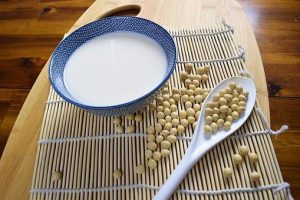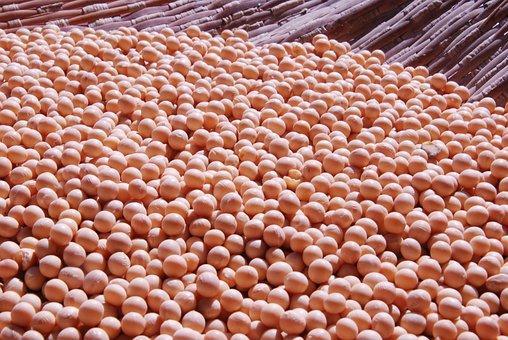Soy is a nutrient-dense food that needs no introduction. These legumes are probably the most famous for their high protein content. However, they also abound in many other essential nutrients, including dietary fiber, B-complex vitamins, and antioxidants.
Another great thing to love about soy is that there’s a wide variety of products to choose from. This article delves into the best types of soy supplements to incorporate into your diet.
1. Edamame
Edamame are commonly confused for a distinct type of cereal. However, these are simply soybeans harvested when the pods are still green.
Edamame contains significantly more vitamin K and vitamin B9 (folate) than mature soybeans. A 160-gram serving provides as much as 56% and over 100% of the recommended daily intake (RDI) of vitamin K and B9, respectively.
Edamame is also higher in vitamin B5, vitamin C, and manganese than mature soybeans. Besides, these immature soya beans tend to be softer and yummier.
However, standard soybean is richer in protein, vitamin B6, magnesium, copper, iron, and phosphorus. Determining your individual nutritional requirements is key to choosing between edamame and mature soy.
It’s also essential to opt for soy products approved by U.S. Soy or other renowned advocates of healthy, sustainable soy production. U.S Soy is committed to ensuring that all soy supplements are produced in a manner that’s easy on the environment and also safe for the final consumer.. You can also read U.S. Soy news.
2. Whole Soybeans
Whole grains typically provide more nutrients than their processed forms. And soy is no exception.
Whole soya beans are the ripest form of these legumes. They’re usually hard, dry and generally come in yellow color, although some may be black or brown.
Consider whole soybeans if you wish to maximize soy’s nutritional benefits. There are several ways to prepare these legumes too. You can cook and use them in stews, sauces, or soups. There’s also the option of soaking and roasting them for snacks.
3. Soy Nuts
We’ve just mentioned roasting as a popular way to consume whole soybeans. Roasted soybeans are commonly known as nuts.
Ideally, soybeans are soaked in water and then baked until they turn brown. They’re then sweetened using specific flavors.
The final product has a texture similar to that of peanuts but higher in protein and isoflavones.
4. Soy Flour

Many nutritionists will tell you that the best way to consume soy (or any other cereals, for that matter) is in its unrefined form.
Soy flour isn’t completely unprocessed. But the product retains most of the nutrients in whole soybeans.
Soy flour is typically consumed alongside baked goods. It lets you enjoy soy’s dense nutritional profile while also enhancing texture through lipid oxidation.
5. Soy Bread
This is one of the numerous baked goods you can make using soy flour.
Soy bread looks like your regular bread, except that it’s high in soy’s inherent nutrients.
The bread is also yummier than plain soy flour. And depending on the preparation method, it can have just as much fiber content.
6. Textured Soy Protein
The name says it all. Textured soy protein, commonly abbreviated as TSP, are products formulated from textured soy flour. They may also be made from textured soy protein concentrates or spun soybeans.
This form of soy retains most of the bean’s dietary fiber. It can also contain as much as 70% protein.
Textured soy protein has a chewy texture when hydrated. Its most common application is as a meat tenderizer.
7. Soymilk

If you’re a diet-conscious person or are lactose-intolerant, the chances are that you’ve been searching for healthier alternatives to dairy milk. Well, your search ends here.
Soymilk is essentially milk made from soybeans. It’s prepared by soaking whole soybeans, grounding the cereal, and then straining it to separate the milky fluid from the solid residue.
Soymilk is a great source of protein and B-complex vitamins. However, it tends to be lower in vitamin D and dietary fiber compared to whole soybeans. The milk is also lower in calcium than dairy milk. But overall, soymilk is far much better than dairy milk as it’s lactose-free, cholesterol-free, and is loaded with healthy fats.
8. Soy Sauce
Soy sauce may be lower in protein content than whole soybeans. But it provides a more delectable way to enjoy soy’s other nutrients.
The product is basically a dark brown liquid made from fermented soybeans. It goes by numerous names, such as tamari, shoyu, and teriyaki, depending on region and preparation method.
Tamari contains only soybeans while shoyu is a blend of soybeans and wheat. Teriyaki is a combination of soy sauce with other ingredients like sugar and spices.
9. Tofu and Tempeh
Tofu and Tempeh are other tasty ways to enjoy soybeans. The two products are quite distinct from each other.
Tofu, alternatively known as soybean curd, is the result of cuddling soymilk using a coagulant. It’s mildly flavored and is particularly high in B vitamins.
On the other hand, tempeh is the result of mixing whole soybeans with another grain, usually rice or millet. The mixture is then fermented and pressed into a nutty-flavored bar, then consumed as is or added to soups and casseroles.

The Bottom Line
There’s a wide range of soy products to integrate into your diet. Remember, you’re better off with unprocessed and unrefined products.
Should you opt for refined soy supplements, be sure to check the nutrition profile before adding it to cart. Also, read the ingredients list to ensure the product is free from potentially harmful preservatives and flavorings.





